Resolving Dilemmas in Perimetry: Illustrated Manual of Visual Field Defects » książka
topmenu
Resolving Dilemmas in Perimetry: Illustrated Manual of Visual Field Defects
ISBN-13: 9789811626005 / Angielski / Twarda / 2021 / 184 str.
Resolving Dilemmas in Perimetry: Illustrated Manual of Visual Field Defects
ISBN-13: 9789811626005 / Angielski / Twarda / 2021 / 184 str.
cena 442,79
(netto: 421,70 VAT: 5%)
Najniższa cena z 30 dni: 424,07
(netto: 421,70 VAT: 5%)
Najniższa cena z 30 dni: 424,07
Termin realizacji zamówienia:
ok. 22 dni roboczych
Bez gwarancji dostawy przed świętami
ok. 22 dni roboczych
Bez gwarancji dostawy przed świętami
Darmowa dostawa!
Kategorie BISAC:
Wydawca:
Springer
Język:
Angielski
ISBN-13:
9789811626005
Rok wydania:
2021
Wydanie:
2021
Ilość stron:
184
Waga:
0.63 kg
Wymiary:
25.91 x 19.56 x 1.52
Oprawa:
Twarda
Wolumenów:
01











